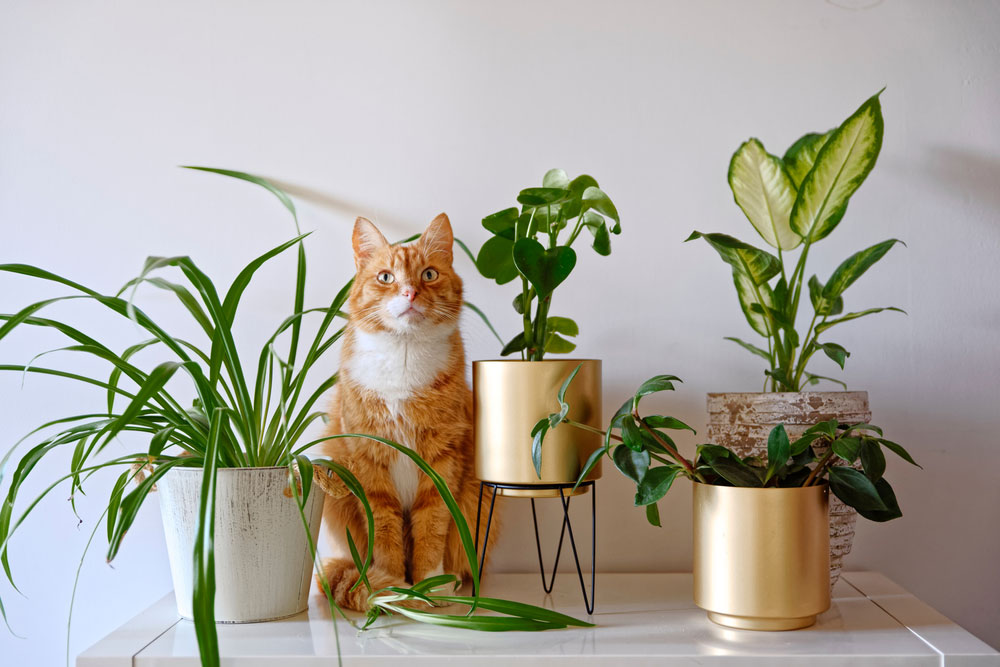Cats are naturally curious—especially when it comes to exploring their surroundings. A new leaf? A dangling flower? To your cat, that’s a snack worth investigating.
But unfortunately, many common houseplants and outdoor garden favorites can pose a serious health risk to cats. Ingesting even a small amount of a toxic plant can cause vomiting, seizures, or even organ failure.
At Parker Center Animal Clinic, we want to help you create a safe, enriching environment for your cat—inside and out. This guide will help you recognize toxic plants, spot signs of poisoning, and take action quickly if needed. Plus, we’ll share helpful tips for designing pet-friendly plant spaces so you can enjoy greenery without putting your cat at risk.
Understanding Plant Toxicity in Cats
Cats have unique metabolisms and grooming behaviors that make them especially vulnerable to certain plant compounds.
- Toxic alkaloids and glycosides can disrupt heart, liver, or kidney function.
- Insoluble calcium oxalates, found in plants like pothos or dieffenbachia, cause intense mouth and throat irritation.
- Lily toxicity is especially dangerous—even licking pollen from their fur can result in kidney failure.
For a full reference, check the ASPCA Toxic and Non-Toxic Plants Guide.
Common Toxic Plants for Cats
Lilies (Lilium & Hemerocallis species) – Extremely Toxic
- Why they’re dangerous: Every part of the lily plant is toxic to cats.
- Symptoms: Vomiting, lethargy, loss of appetite, increased thirst, kidney failure.
Pothos (Devil’s Ivy)
- Why they’re dangerous: Contains calcium oxalates that cause pain, oral ulcers, and swelling.
- Symptoms: Drooling, vomiting, pawing at the mouth.
Sago Palm
- Why they’re dangerous: Contains cycasin, which can cause liver failure.
- Symptoms: Vomiting, diarrhea, jaundice, seizures.
Aloe Vera
- Why they’re dangerous: Contains compounds that can upset the GI tract.
- Symptoms: Vomiting, diarrhea, tremors, lethargy.
Tulips & Daffodils
- Why they’re dangerous: Contain alkaloids that affect the heart and digestive system.
- Symptoms: Drooling, vomiting, irregular heart rhythm.
Recognizing Signs of Plant Poisoning in Cats
If your cat has been chewing on plants or you’re unsure what they’ve ingested, watch for:
- Gastrointestinal signs: Vomiting, diarrhea, drooling, loss of appetite
- Neurological signs: Tremors, seizures, disorientation, collapse
- Kidney or liver issues: Increased thirst, urination, jaundice, lethargy
Time matters. If you notice any of these symptoms, seek veterinary care immediately.
Emergency Steps: What to Do If Your Cat Eats a Toxic Plant
- Remove the plant from your cat’s access.
- Check for symptoms and note when they started.
- Call a veterinarian or poison control hotline right away:
- ASPCA Animal Poison Control Center
- Pet Poison Helpline: (855) 764-7661
- AVMA Emergency Resources
- ASPCA Animal Poison Control Center
- Bring your cat in for care and, if possible, bring a sample or photo of the plant.
Treatment may include IV fluids, anti-nausea medication, activated charcoal, or hospitalization depending on the toxin involved.
Creating Cat-Safe Plant Spaces Indoors & Outdoors
If you love plants and your cat loves to investigate, don’t worry—you don’t have to choose between them. With a little planning, you can enjoy your greenery and keep your cat safe.
Tips for Cat-Friendly Indoor Plant Areas
- Use high shelves or wall-mounted plant stands your cat can’t reach.
- Install ceiling or wall plant hangers to display trailing plants away from curious paws.
- Group plants in closed terrariums or glass cloches for decorative but safe displays.
- Use deterrents like citrus-scented sprays or aluminum foil at the base of pots.
Watch out for potting soil and fertilizers! Even if the plant itself is non-toxic, soil additives such as fertilizers, pesticides, and moisture-retaining crystals can be dangerous if ingested.
Outdoor Plant Safety: What to Avoid in Your Garden
Outdoor cats love to explore garden beds and landscaping—but many popular plants are highly toxic. Be cautious with:
- Lily species (especially Easter and Asiatic lilies)
- Onions and garlic (all parts, including bulbs and greens)
- Foxglove, oleander, larkspur, azalea, rhododendron, and hydrangea
Also be wary of mulch. Dyed mulch may contain chemicals or mold spores, and cocoa mulch (made from cocoa shells) is toxic to both cats and dogs.
Want to grow a garden just for your cat? Try planting:
- Catnip
- Cat grass (wheatgrass or barley)
- Rosemary
- Valerian
- Calendula
- Chamomile (in moderation)
Make sure you use organic soil without added fertilizers or pesticides, and avoid cocoa mulch or synthetic weed barriers.
Preventing Plant Poisoning at Home
- Stick with non-toxic plants like spider plants, Boston ferns, calathea, and areca palms.
- Supervise curious cats around new plants or decorations.
- Use plant-safe barriers when decorating for the holidays (poinsettias, mistletoe, and holly are all toxic).
- Keep your vet’s number on hand and familiarize yourself with common local plant dangers.
Visit the FDA’s guide to household hazards

How Parker Center Animal Clinic Can Help
At Parker Center Animal Clinic, we take plant toxicity seriously. Whether your cat is showing symptoms or you simply want to pet-proof your home, we’re here to help.
Your home and garden can be beautiful—and safe for your cat. With a little knowledge and planning, you can grow spaces that nourish your soul without risking your pet’s health.
Let us help you build a safe, green home for everyone. If you think your cat has eaten something harmful—or if you want help creating a safer home—contact us today to schedule an appointment.






